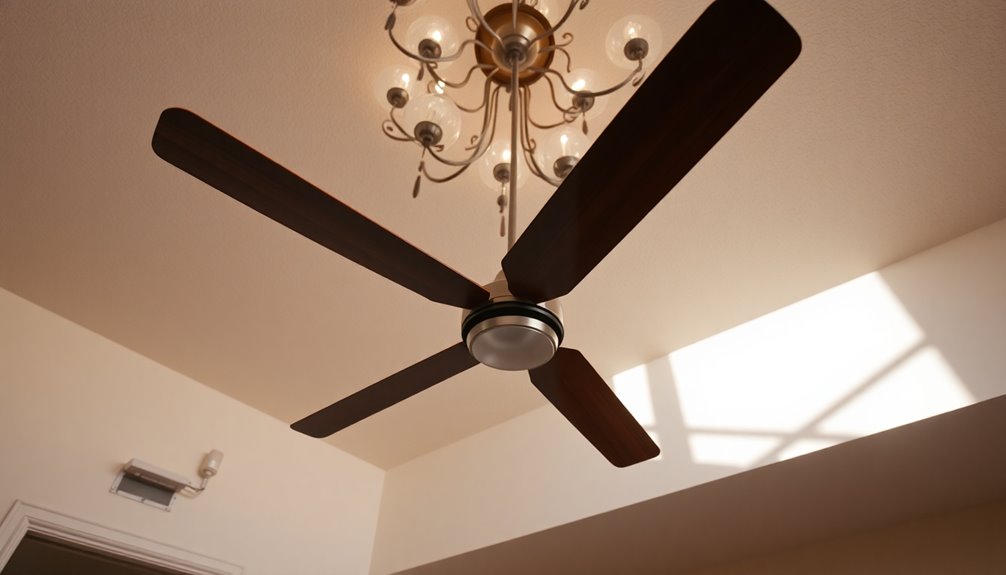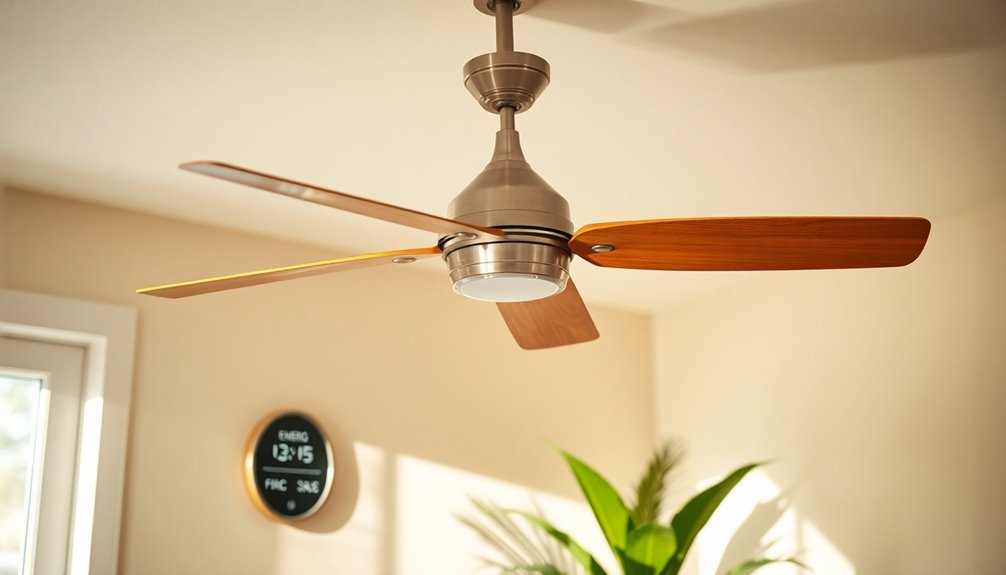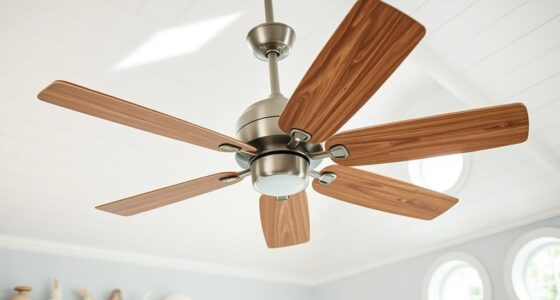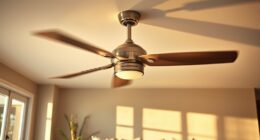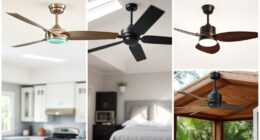Yes, ceiling fans do have thermal fuses, which are essential for preventing overheating and reducing fire hazards. If the fan's thermal fuse blows, it stops power to the light kit while the fan may continue to run. You can find replacement fuses at hardware stores or online. Be cautious not to bypass a blown fuse, as this can pose serious safety risks. Regular maintenance, like checking connections, can help keep your fan running smoothly. There's a lot more to learn about maintaining a ceiling fan and ensuring it operates safely and efficiently.
Key Takeaways
- Ceiling fans commonly include thermal fuses, known as Limitors, to prevent overheating and potential fire hazards.
- A blown thermal fuse stops power to the light kit while allowing the fan to operate.
- Replacement thermal fuses, such as NTE8118 or NTE8125, are widely available at hardware stores.
- Bypassing a thermal fuse poses serious safety risks and should be avoided.
- Regular checks and replacements of thermal fuses ensure safe operation of ceiling fans.
Understanding Ceiling Fan Functionality

When it comes to understanding ceiling fan functionality, it's important to know how these devices operate and the safety features they include. One vital component is the thermal fuse, often called a Limitor. This safety feature prevents overheating, which can lead to fire hazards.
The thermal fuse is designed to blow when the fan exceeds a specific temperature, cutting off power to the light kit and stopping the fan's operation.
If you notice that your ceiling fan's lights stop working while the fan itself continues to run, a blown fuse might be the issue. It's a clear sign that you need to inspect the fan for potential replacement of the thermal fuse. You can easily find replacement thermal fuses at hardware stores, online retailers, or directly from manufacturers to guarantee compatibility with your specific fan model.
While bypassing a blown thermal fuse may temporarily restore your light kit's functionality, it poses serious safety risks. Ignoring the underlying issues can lead to overheating and possible fire hazards.
Always prioritize your safety by addressing any problems with your ceiling fan promptly.
Common Electrical Issues

Electrical issues can be a common headache for ceiling fan users, often manifesting in flickering lights or a fan that won't respond.
These problems might stem from a loose connection or wiring issue, which can hinder your fan's performance and even affect the fan speed. If you notice your ceiling fan frequently trips the breaker or blows fuses, it's essential to address these electrical problems promptly to avoid potential hazards.
Regular maintenance can help prevent these issues. Checking and tightening electrical connections can make a significant difference in your fan's reliability.
If you're not comfortable performing these checks, don't hesitate to call a professional electrician. They can identify underlying problems that mightn't be immediately visible, ensuring your ceiling fan operates safely and efficiently.
Troubleshooting Ceiling Fan Problems

Although ceiling fans are generally reliable, troubleshooting common problems can help restore their functionality and improve your comfort.
If your ceiling fan lights stop working while the fan continues to operate, it could signal a blown inline fuse. You can test this fuse with a multimeter to determine if it's the culprit. Many ceiling fans come equipped with a thermal fuse, often labeled Limitor T160, which protects against overheating by shutting off power when excessive heat is detected.
If you suspect a blown fuse, consider replacing it with a compatible option, like the NTE8118 or NTE8125, easily found at electronics retailers or online marketplaces.
While it might be tempting to bypass a blown fuse for temporary light functionality, resist the urge; this poses serious safety risks, including overheating and potential fire hazards.
Regularly inspecting your ceiling fan's electrical connections and components, including the thermal fuse, can help prevent malfunctions.
If you're unsure about troubleshooting or replacement, don't hesitate to call a professional to guarantee safe and effective repairs. Your safety and comfort should always come first!
Safety Precautions for Fans

How can you guarantee your ceiling fan operates safely? First, you should understand the importance of the thermal fuse, which helps protect against overheating and potential fire hazards. This fuse, like the Limitor T160, interrupts the electrical circuit if excessive heat is detected.
It's vital to never bypass this fuse, as doing so might temporarily restore light functionality but greatly increases the risk of overheating and fire.
Make it a habit to regularly check the functionality of the thermal fuse and replace it with compatible options, such as NTE8118 or NTE8125, to make certain your fan runs safely.
Before inspecting or repairing any electrical components, always disconnect power at the circuit breaker. This step is an essential safety precaution that shouldn't be overlooked.
Additionally, be mindful of the wattage limits when selecting bulbs for your ceiling fans. Adhering to these limits prevents thermal fuse failures and contributes to safe operation.
Replacement and Repair Options

When it comes to keeping your ceiling fan in top shape, knowing your replacement and repair options is vital. Ceiling fans often contain thermal fuses, like the Limitor T160, which prevent overheating and potential fire hazards. If your fan isn't working, a blown fuse might be the culprit.
Here's a quick reference for replacement fuses:
| Fuse Model | Where to Buy |
|---|---|
| NTE8118 | Radio Shack, Amazon |
| NTE8125 | Eck Electrical Supply, eBay |
| Limitor T160 | Manufacturer's website |
| Generic Thermal Fuse | Local hardware stores |
| Check Compatibility | Manufacturer support lines |
When you need to replace a blown fuse, always verify it's compatible with your fan model to avoid further issues. It's tempting to bypass thermal fuses, but doing so can lead to severe safety risks, including fires. Many manufacturers, like Hunter, provide customer support for replacement parts and may cover thermal fuses under warranties. Addressing the underlying issue is significant for safety and longevity, so don't overlook the importance of replacing failed components properly.
Frequently Asked Questions
Why Did the Ceiling Fan Suddenly Stop Working?
If your ceiling fan suddenly stops working, it could be due to several issues.
Check the pull chain switch; if it's faulty, the fan won't receive power.
Inspect the wiring connections, as loose or damaged wires can interrupt the flow.
Also, consider whether you've overloaded the circuit, which might trip the breaker.
Using a multimeter or voltage tester can help you determine if power is reaching the fan's motor or light kit.
Is There a Reset on Ceiling Fans?
When your ceiling fan suddenly stops, it can feel like a storm cloud hovering over your room.
Unfortunately, most ceiling fans don't have a dedicated reset button. If you're experiencing issues, turn off the power at the circuit breaker for a few minutes, then turn it back on.
Sometimes, re-pairing your remote might be necessary after a power interruption. Always check for tripped breakers first before diving into any resets.
Why Does My Ceiling Fan Have No Power?
If your ceiling fan has no power, start by checking the circuit breaker; a tripped breaker can easily cut off power.
Next, inspect the pull chain switch for faults and verify all wiring connections are secure.
Look for any damaged wires or loose connections that might disrupt the flow.
Finally, confirm you're using the right wattage bulbs, as exceeding limits can trigger safety features that stop the fan from working.
How to Tell if a Ceiling Fan Is Bad?
Imagine your ceiling fan as a classic car; if it's sputtering or shaking, something's off.
To tell if your ceiling fan's bad, listen for unusual noises like humming or buzzing, check for flickering lights, and watch for excessive wobbling.
If it won't start or operates intermittently, investigate wiring issues.
Frequent circuit breaker trips can signal serious electrical problems.
Address these signs promptly to avoid further damage or safety hazards.
Conclusion
In conclusion, understanding your ceiling fan's functionality, recognizing common electrical issues, and troubleshooting problems can make all the difference. By following safety precautions and knowing your replacement and repair options, you can guarantee a smooth and efficient operation. So, whether you're fixing a flickering light, replacing a worn-out motor, or simply enjoying a cool breeze, you're empowered to keep your ceiling fan running smoothly. Stay informed, stay safe, and enjoy the comfort it brings!
